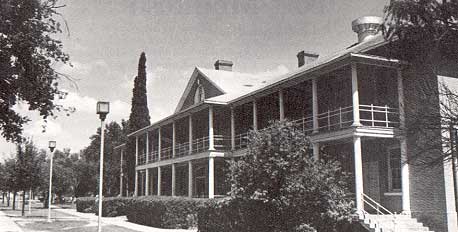
Photo of barracks taken by Charles M. Robinson, III from the book, Frontier Forts of Texas.
As you drive up the overpass on Washington Street heading
west toward Laredo Community College, you step back into a different
time in Laredo's history. The present college site is the location of
Fort McIntosh established in 1849. It is also near the point of an old
Spanish and Indian river crossing.
It is appropriate that Washington Street becomes Lamar Road named after
Mirabeau B. Lamar, President of the Republic of Texas. After the Mexican
War, Lamar warned of the precarious, but also important, position the
city of Laredo was in and conveyed the urgency of insuring protection
for citizens and territory.
Accordingly, on March 3, 1849, Camp Crawford, named after George W.
Crawford, Secretary of War under President Zachary Taylor, was established
on the orders of Captain George Dias, Assistant Adjutant General as
requested by Major-General William Worth. Lieutenant Egbert L. Viele,
the fort's first commander, had been commander of Company G of the 1st
Infantry at Ringgold Barracks located near the town of Rio Grande City
about 100 miles down river from Laredo. Viele holds the distinction
of being the first commander of Fort McIntosh.
By 1850, the fort was renamed in honor of Lieutenant Colonel James
Simmons McIntosh a hero in the Battle of Molino del Rey on September
26, l847. Forts Worth, Graham, Gates, Croghan, Scott, Lincoln, Duncan,
and McIntosh were established around this time to guard the frontier.
These outposts were named in honor of fallen officers in the Mexican-American
War.
Today, Fort McIntosh is marked by four distinct architectural eras:
Early Fort McIntosh Period 1849-1861, Civil to Spanish-American War
Period 1861-1898, Modern Fort McIntosh Period 1900-1945, and Laredo
Community College Period 1946- present. The street names honor fallen
heroes, presidents, fort commanders, officers, and soldiers.
Since l947, the fort has served as the home of Laredo Community College.
Like so many community colleges in this country, the college was founded
as the need for post-secondary education increased after World War II.
Through the years, many modern buildings, designed to incorporate the
latest in technology and design, have been added. The latest addition,
the De la Garza Building with its sunburst windows, offers us a look
at the site's past as a fort looking out toward the river. Much as the
Indians and Spaniards did, we do not see a boundary, but a bridge to
the future.
Communities and Related Links
|